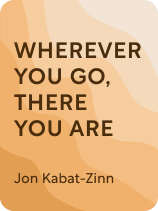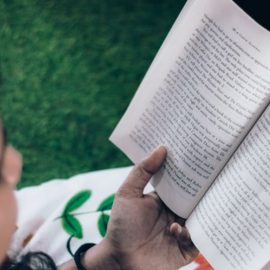

This article is an excerpt from the Shortform book guide to "Wherever You Go, There You Are" by Jon Kabat-Zinn. Shortform has the world's best summaries and analyses of books you should be reading.
Like this article? Sign up for a free trial here.
What is Wherever You Go, There You Are by Jon Kabat-Zinn about? What are the main takeaways of the book?
Many people struggle to get started with mindfulness or need a new routine. In Wherever You Go, There You Are, Jon Kabat-Zinn provides a guide for anyone who’s interested in exploring mindfulness further, from the tentative beginner to the seasoned practitioner.
Read below for a brief overview of Kabat-Zinn’s book.
Wherever You Go, There You Are by Jon Kabat-Zinn
In Wherever You Go, There You Are, Jon Kabat-Zinn offers an introduction to mindfulness as well as practical strategies for incorporating mindfulness into your daily life. Kabat-Zinn argues that many of us exist in a constant state of distraction, either preoccupied with the past or worried about the future. Mindfulness, he explains, is a tool that will allow you to stay fully present and recognize the extraordinary gift of each moment.
Kabat-Zinn is a meditation teacher who is often credited with bringing mindfulness practice to mainstream medicine and into public awareness. He is also a professor emeritus of medicine at the University of Massachusetts Medical School where he founded the Mindfulness-Based Stress Reduction Clinic in 1979 and the Center for Mindfulness in Medicine, Health Care, and Society in 1995. He is the author of several books on mindfulness including Full Catastrophe Living, Coming to Our Senses, and Everyday Blessings, which he co-authored with his wife Myla Kabat-Zinn.
Wherever You Go, There You Are was published in 1994 and is often cited as one of the must-read books on mindfulness, both for those who are brand new to mindfulness and those who have been practicing for a long time.
What Is Mindfulness?
The language of mindfulness has become increasingly common in everyday vernacular. But what is it really?
According to Kabat-Zinn, mindfulness is the practice of noticing the present moment and observing it without judgment. Without mindfulness, he argues, many of us move through our day preoccupied with things that happened in the past, worried about things that might happen in the future, or simply caught up in the chaos of our own thoughts. By doing this, we fail to appreciate what’s happening right in front of us.
Mindfulness is a tool to interrupt an otherwise habitual lack of awareness by offering the opportunity to pause and notice what’s going on around you and inside you. Kabat-Zinn clarifies that pausing (what he calls “non-doing”) shouldn’t be confused with doing nothing. When we do nothing, time often passes without our awareness; mindfulness, on the other hand, requires deliberate intention and awareness. We can pause when we’re standing still or in the midst of an activity. The key is paying attention to what’s happening and detaching yourself from the desire to control or change the present moment.
Kabat-Zinn emphasizes that the awareness required in mindfulness is different from thinking. Thinking is the flow of ideas and feelings inside your head, while mindfulness is the observation of those thoughts. So mindfulness isn’t about thinking differently or thinking less, but about stepping back from your thoughts to notice them. In stepping back from your thoughts, you prevent yourself from getting lost in your thinking. Instead you can observe your thoughts objectively and learn from them.
Why Is Mindfulness Important?
Having explained the basic principles of mindfulness, we’ll now outline why mindfulness matters. Kabat-Zinn argues that cultivating a mindfulness practice is worthwhile because it’ll allow you to live a richer life, know yourself better, make more intentional choices, and appreciate your connection to something larger than yourself.
Experience the World More Fully
First, Kabat-Zinn explains that mindfulness has the power to make your life richer and more vibrant. Our experience of the world is often filtered through the stories we tell ourselves about our experiences. In this way, our thoughts, assumptions, and perceptions of reality distort our experience of the world. For example, if it’s raining, you might feel annoyed that you forgot your raincoat or worried that traffic will be worse, but when you practice mindfulness, you’ll instead notice how the rain feels or sounds as it falls.
Second, mindfulness connects us with what we’re experiencing. Most of us spend our days thinking about things disconnected from the current moment. Usually this means replaying things that have happened in the past or planning for the future. Kabat-Zinn argues that the current moment is the only thing that’s real—therefore, if we spend our lives too distracted to notice what’s right in front of us, then it’s like we’re living half-asleep, letting our lives pass us by unnoticed and unappreciated and never experiencing the full beauty and complexity of the world directly.
Know Yourself Better
Mindfulness is also the practice of getting to know yourself better. Many of us suffer from distorted thinking that downplays our strengths and overemphasizes our faults. Mindfulness enables us to cultivate true self-awareness, free from the ongoing internal monologue of self-criticism. Mindfulness doesn’t demand that you improve yourself, only that you see and honor yourself exactly as you are.
Kabat-Zinn explains that mindfulness can also empower you to be the authority on your life, body, and experiences. If you’re fully aware of what you’re thinking and how you’re feeling, then you’ll become a more effective advocate for what’s best for your physical, mental, and emotional health.
Make Intentional Choices
Being the authority on your life can empower you to take control of your life. Kabat-Zinn explains that people often blame their circumstances for their problems, but he argues that the answers to your problems lie within you. Instead of looking for the answers to your problems elsewhere, Kabat-Zinn argues that mindfulness helps you turn inward, ask questions, and then make informed decisions that help you take intentional steps in the direction you want to go.
He adds that without mindfulness, it’s easy to make decisions based on impulse or habit. But in the practice of mindfulness, you observe these impulses arise without acting on them, so when you do make a decision, you do so with awareness and intention. For example, if you’re feeling unhappy at work, it’d be easy to blame annoying colleagues or a negative work culture. Mindfulness practice helps you become more aware of how your own habits and interactions might be contributing to negativity at work, allowing you to make more thoughtful choices that improve your life and the lives of others.
Connect With Something Larger
Not only does mindfulness help you live your life more intentionally, it also connects you to something larger than yourself. As you cultivate your mindfulness practice, you become aware of how everything is interconnected, how one moment connects to the next, and how many moments had to align to bring you to exactly where you are today. This awareness helps you appreciate the importance of every moment, even as you recognize that each moment is fleeting.
How Do You Practice Mindfulness?
After developing a greater understanding of the importance of mindfulness, how do you start practicing?
Kabat-Zinn emphasizes that anyone can practice mindfulness because mindfulness is simply about being who you are. However, he does highlight certain values that you can cultivate in your daily life that will help you sustain and nurture your mindfulness practice: simplicity, patience, vulnerability, and perseverance.
Focus on Your Breath
Whether you’re practicing mindfulness in your daily life or doing a more structured meditation practice, your breath is an invaluable tool; it provides you with something to draw your attention back to when your mind wanders. Wherever you are, and whatever you’re doing, you can breathe naturally, paying attention to what it feels like to have your breath move in and out of your body. Notice where you’re most aware of your breath and the sensations of your breath as it enters and leaves your body.
Practice Mindfulness Through Meditation
The first place you can practice focusing on your breath is during formal meditation practice. If you’ve never practiced mindfulness before, it can be helpful to set aside short periods in your time to implement a more formal meditation practice. That way you can focus fully on your practice and get comfortable honing your focus before trying to introduce mindfulness more regularly into your daily life.
In meditation practice, there’s no one right way to meditate. Kabat-Zinn describes meditation as being like walking along a trail. With each step, you make split-second decisions about where to put your foot next and how you step. Each step you take informs the following step. Rarely do you have to think about where you step next—you just do it. Just like walking along a trail, there’s no one way to practice meditation. Everyone will do it differently, so don’t think about what’s supposed to happen, just practice being aware of what is.
Just as there’s no right way to meditate, there’s also no right amount of time to practice. The amount of time isn’t important. As Kabat-Zinn explains, every second is another opportunity to be present. Over time you’ll build up your stamina and be able to meditate for longer and longer periods.
Meditation practice can happen at any time of day, although Kabat-Zinn makes a plug for the early morning, which he describes as an especially fruitful time to meditate. Mornings, he explains, are naturally still. More often than not it’s dark and you’re alone. Moreover, waking up early requires the same discipline required to meditate, so early morning meditation gives you the opportunity to more easily observe your mind’s objections and resistance to practicing. Finally, he explains, when you start your day with mindfulness the benefits are more likely to stay with you through the rest of the day.
Mindfulness in Your Daily Life
While a formal meditation practice can help strengthen your ability to focus, the purpose of meditation is to live your life more mindfully every day. Every moment and activity is an opportunity for mindfulness. Mindfulness doesn’t require a specific activity or environment; it can happen anywhere at any time. Just pause and pay attention, using your breath as your focal point.

———End of Preview———
Like what you just read? Read the rest of the world's best book summary and analysis of Jon Kabat-Zinn's "Wherever You Go, There You Are" at Shortform.
Here's what you'll find in our full Wherever You Go, There You Are summary:
- A guide to mindfulness for both beginners and seasoned practitioners
- How to incorporate mindfulness more intentionally into your daily life
- How to practice mindfulness through meditation






